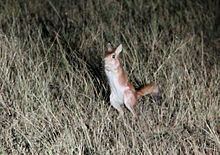Kingdom Animalia Class Mammalia Suborder Anomaluromorpha Scientific name Pedetes surdaster | Phylum Chordata Order Rodentia Family Pedetidae Rank Species | |
 | ||
Similar Pedetes, Pedetidae, Anomaluromorpha, South African springhare, Long‑eared flying mouse | ||
Pedetes surdaster, the East African springhare, is not closely related to the hare, but is a member of the Pedetidae, a rodent family.
Contents
Taxonomy
Pedetes surdaster was recognised by Matthee and Robinson in 1997 as a species distinct from the southern Africanspring hare (P. capensis) based on genetic, morphological, and ethological differences. P. capensis from South Africa has fewer chromosomes (2n= 38) than does P. surdaster which has (2n = 40) and some other genetic variations. The species was confirmed by Dieterlen in 2005.
Distribution
This species is found in central and southern Kenya and most of Tanzania. A single specimen has been recorded in Uganda near the Kenya border, at Mount Moroto. It is found from sea level up to an altitude over 2,000 m.
Description
The East African springhare resembles a small kangaroo and is about the size of a rabbit. It is mid-brown, has large erect ears, very short fore legs, and long powerful hind legs. It moves in bounds of up to 2 m and has a long tail fringed with black hairs which provides balance. It can sit up on its haunches like a squirrel.
Ecology
The East African springhare is nocturnal and spends the day in an extensive system of burrows. It lives in semiarid grassland habitats. The diet is the green parts of plants, roots and other vegetable matter, and occasionally insects.
